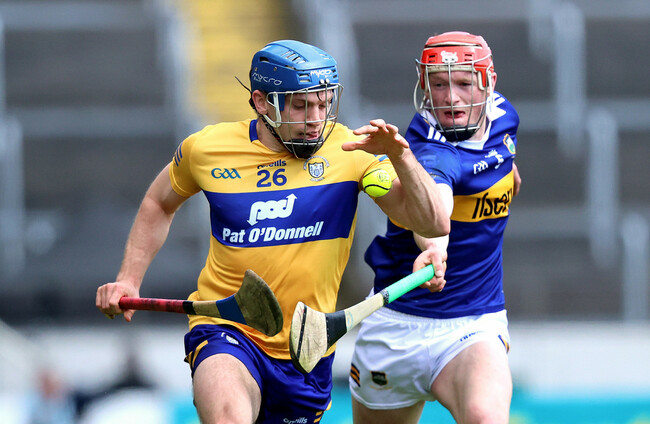LAST UPDATE | 26 Apr 2022
ON A FRIDAY night in December 2018, Limerick took on Tipperary in the Gaelic Grounds in the Munster Hurling League. As I drove through the city of Limerick it was hopping with Christmas parties and I couldn’t help but get thirsty for a few pints as I watched crowds move through the streets.
There was another man thirsty in Limerick that evening and it was the newly appointed Tipperary hurling manager. I met Liam Sheedy before the game and one of the things he wanted was an insight into Limerick’s movement on their long puck-out.
We watched Cork come up with similar movements on their puck-outs in 2017 and 2018 but when a team delivers an All-Ireland title, it inevitably leaves the opposition pondering what they can do in response.
Before the match, I was instructed to position myself behind the goals and look at the movement of Hegarty, Reidy and O Connell who were the half-forward line for the night.
While watching the Limerick forward movement and viewing the footage of the game in the weeks after, it dawned on me that Tipperary were probably not going to get to a level over the next six months where they could replicate the movement of John Kiely’s men.
That night in December did serve a purpose. It offered an opportunity for Sheedy and his management to learn lessons on how to defend the opposition’s long puck-out and this approach ended up being a key pillar of Tipperary’s 2019 All-Ireland win.
When James Owens blew the whistle in that year’s final, Tipperary had scored 2-7 from turning over the Kilkenny long puck-out. Sheedy’s outfit finished that season scoring 4-36 from turning over the opposition’s long puck-out. This was 20% of Tipperary’s total score in the 2019 championship.
What became of Tipperary’s long puck-outs?
2019 did not see a huge improvement in Tipperary’s long puck-out from previous years and at the end of the championship, they secured just 38% and conceded 0-20 from Brian Hogan’s long restarts. But, as often happens in hurling, management’s work does not bear fruit immediately. Their work saw an improvement in their restarts over the next two years.
Fast forward to Sunday’s clash in Semple Stadium and Tipperary’s woes resurfaced. The defeat to Clare saw Colm Bonnar’s men secure just 32% of their long puck-out. Clare’s two goals originated from Tipperary going long and being turned over on the breaking ball.
Clare deserve credit for using a simple tactic. The same was used by Brian Cody’s successful Kilkenny teams as far back as the mid-2000s. But some of the blame must be levelled at Tipperary and their lack of organisation.
Their set-up does not allow their players to contest the breaking ball against the opposition with equal numbers.
A Question that applies from Junior B to inter-county
To be fair to Colm Bonnar and his Tipperary side, they are not the only team who are struggling to secure possession from their long restarts.
The issue that faced Tipperary on their long puck-out is one that every team faces across the country from Junior B level to inter-county. It occurs when the opposition’s midfielders and half forwards get a head start to the break from the long puck-out.
The influence of Shane O’Donnell in the lead up to the two Clare goals highlights the issue for Tipperary but also for other teams around the country.
If we look at Clare’s second goal, Brian Hogan is scanning options for a puck-out, but the Clare full-forward line have cut off any potential out ball to the Tipperary half backline. The Tipperary half-backs are drawn closer to their own goal to look for the restart. Thus, Hogan decides to deliver the ball long. It gives Shane O’Donnell a head start to the breaking ball area.
As the ball breaks in the Clare half-back line, Brian Lohan’s men just have to contest the high ball and not worry about winning clean possession. They have two players inside the Tipperary defenders which gives them an opportunity to be first to the break.
When Clare secured the breaking ball they can play the ball out to O’Donnell and within five seconds, the Eire Og Ennis man received possession on two occasions. This allowed him to release John Conlon into the space which Quirke vacated.
Long puck-0ut performances 2019 – 2021
Last week’s article analysed the short puck-out. The overuse of this tactic perplexes many supporters. But there is a reason teams opt for the short option. It is because they are struggling to turn their restarts into possession in the opposition’s half of the pitch.
There were 2842 long puck outs hit by teams in the 2019, 2020 and 2021 championships which saw a retention rate of 49% from these restarts.
Stats: GAA Insights
The breaking ball
The winning of the breaking ball is a huge issue for most teams on their long puck-out. Over the last three championships, 1861 long puck outs resulted in a breaking ball contest and teams only won 43% of the breaks from their long restarts.
Many cliches are used to describe a team’s ability to win the breaking ball. Hunger, fitness, and an ability to win the dirty ball. All are important ingredients, but there are some other forces at play. There is a tactical and structural issue for most teams as demonstrated in Clare’s turnover of the Tipperary puck-out before their goals last Sunday.
In the modern game, the set-up on the opposition’s puck out is as much of an attacking tool as a team’s own long puck-out. For new coaching tickets, it is an area in which you can receive a quick hit on and gain some trust with the squad.
Managers can quickly coach players on what space to cover and what players to mark before the opposition hit a restart. The retention rates show that defenders are marginally getting the better of teams on their restarts.
When Waterford played Kilkenny in the 2020 All Ireland semi-final, Liam Cahill’s full-forward line covered any out ball to the Cats’ half-back line. This allowed the Waterford half forwards to occupy space on the wings and cover the Kilkenny midfielders if they move into a pocket of space.
As a result, Waterford’s midfield gained a head start to the breaking area if Kilkenny hit a long puck-out into the Waterford half.
For me, a team’s performance on the breaking ball can’t be analysed simplistically with cliches like hunger and ball winners. Kilkenny have those qualities in abundance but they struggle to secure breaking ball off their own puck-out.
How teams are performing on the breaking ball from their long puck-out from 2019 – 2021
Where are the natural ball-winners gone?
Despite their struggles to win breaking ball from their long puck-out, Cork and Kilkenny are two of the top three teams with the ability to win clean possession from their long puck-out over the last three championships. Both counties do it in very different ways with Kilkenny relying on their individual ball-winning ability and physical strength from the long delivery.
While Cork and Waterford rely on the movement from their front eight players to create pockets of space.
There is a valid reason why the majority of teams are hitting 55% of their puck-outs long and 45% of their puck-outs short. Teams in the modern game are struggling to convert their short and long puck-out into possession in the opposition’s half of the pitch.
Conclusion
The likes of Cork are now hitting more short puck-outs than long puck-outs in a game. It should be said that the refereeing of restarts plays a vital role in how puck-outs are hit. The clampdown on fast puck-outs is leading to some fantastic tactical battles.
At the moment we are in the nullifying stage of the puck-outs but teams like Limerick are coming up with methods of securing possession in the opposition’s half. It is up to the rest of the country now to innovate on their restarts and come up with ways of protecting themselves but also attacking teams from their long puck-outs.
Work rate is a basic requirement for all teams. In reality, very few players go out at this level and are not willing to work hard. A team’s lack of organisation can mean players are not in the right places at the right time. They arrive late to the play. It looks like they are not working hard but it is about structure.






















Great article.
Great to read about Billy and the way life turned out for him.i
I can remember him as a kid in Middleton when I stayed with his parents Don and Mary.I will never forget their kindness towards me as I was starting out in my first job in nearby Carrigtouhill.
Great read. Never forget his goal for Rovers against Shels in the cup. Belter. On his day he was unstoppable.
Nobody underachieves. If you have the skill, but not the motivation, you’ll achieve exactly how much you should achieve with that combination.
@Ryan Comiskey: what if you have the motivation but not the skill?
@Kieran Stafford: you’ll still likely achieve your potential – whatever that may be.
Great article and gives a no holds account of the times of Leage of Ireladn football from players perspective and still after his football experiences has great love still for Cork.
Jaysus that suit looks shocking on Dolan . Fits like he ordered it online or something
@Ronan McDermott: …would you like if it was a “slim” fit?!…on Dolan?!
Great read I remember Celtic played City in 2001 and brought a full strength team bar Larsson. The game finished 3-2 to Celtic that night too. I’ve the ticket on my bedroom wall still.
Great read. Billy scored against Rovers out at Bishopstown once, off the left wing into the right top corner. Best goal I’ve seen in the flesh. Glorious stuff.
Great read. Never forget his goal for Rovers against Shels in the cup. Belter. On his day he was unstoppable.
@David Linehan: alright David boy once was enough to say it !
“Billy Woods was on the wing
we had dreams and songs to sing”
Immortalised in song, doesn’t get much better than that.
I remember the slagging Billy got at the Cross when City played Rovers.
One fella roared”Welcome back Billy, you havent changed. You’re still shite”
I remember the slagging Billy got at the Cross when he came with Rovers.
One fella roared ” Welcome back Billy, you havent changed. You’re still shite”